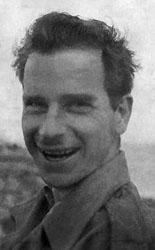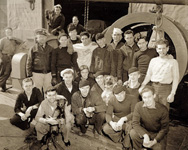 |
 |
 |
 |
| The Men | The Spirit | The Ship | The Mission |
USCG CABLE SHIP PEQUOT - UNITED STATES HARBOR DEFENCES
OUR SAILORS' STORIES
This page tells another one the stories of the sailors who served aboard the U.S. Coast Guard Cable ship Pequot during World War II. The Pequot served as a harbor defense cable-laying and repair ship under direction of the US Navy. Her full story can be found on the Pequot Home Page.
JOHN J. MCCORMACK'S STORY
|
1. John J. McCormack Pequot Radioman 1st Class |
John McCormack grew up in Nyack, New York on the Hudson
river just north of New York City. He was in the sea scouts as a boy and
studied radio after high school. Two months before the attack on Pearl
Harbor, he enlisted in the US Coast Guard on October 23rd 1941 at the
New York City Recruitment Office. With his nautical and radio background
he was perfect for the Coast Guard, and after basic training he went to
radio school.
His first shipboard assignment was as a radioman on the CG
cutter Storis (WAGL-38) where as a member of the original crew, he was a
"plank owner" when the ship was commissioned in September, 1942.
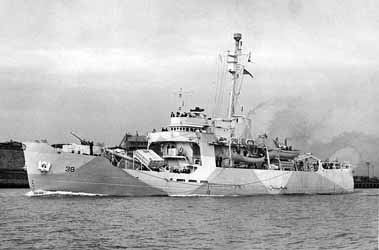 |
 |
| 2. The US Coast Guard Cutter and Icebreaker Storis (WAGL-38) in her WWII camouflage during 1943 (US Coast Guard Photo) | 3. John took this photo of one of his shipmates on top of the Storis' superstructure. Above him, protected by a tarpaulin cover, is the "gun detector" for the fire control system on the Storis which was an emerging technology at the time |
Storis was built as unique hybrid ship and was the only vessel of
her class - an armed icebreaker and buoy tender specifically designed
for arctic operations. She weighed 1715 tons and carried a J2F-5 Duck
Grumman seaplane along with her 150 man crew.
 |
 |
| 4. On her stern deck Storis carried a Grumman J2F-5 Duck seaplane which proved a valuable asset during search and rescue operations. Nicknamed "The Ugly Duckling" it could also carry two 375 lb depth bombs for hunting U-boats. (US Coast Guard Photo) | 5. The Storis foredeck and gun tub photographed by John from up in the crow's nest bucket on the main mast. |
Initially John was stationed with Storis out of Boston where
the ship was on anti-submarine patrol around Casco Bay, Maine, until May 19th
1943 when she escorted a convoy to Argentia, Newfoundland and Narsarssuak,
Greenland.
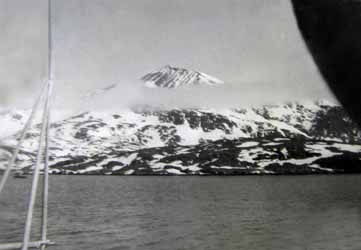 |
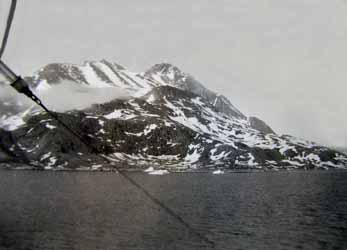 |
| 6, 7. We can see ice floes and small icebergs along the shore as Storis moves past the dramatic and rugged scenery of Greenland while on patrol duty. | |
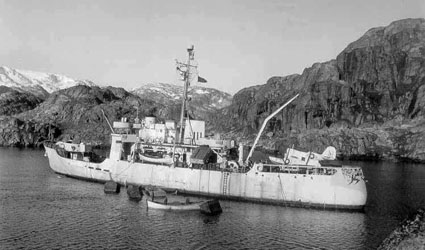 |
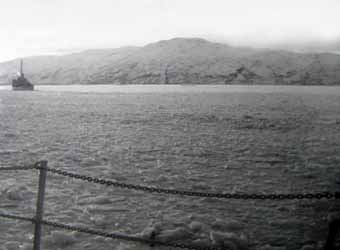 |
| 8. Here in a sheltered inlet in Greenland we can see the rear boom arm on Storis elevated to launch her seaplane into the water in 1945. (US Coast Guard Photo) | 9. Here we see the Storis following another ship as they move through an arctic bay clogged with ice |
Storis became part of the Greenland Patrol which helped defend
and supply the Danish settlements and Eskimo villages on the island. Along
with other Coast Guard cutters she was tasked as; an icebreaker with keep
convoying routes open, for search and rescue work, for convoy escort and
patrol duty, for running surveys, and to help maintain communications among
Greenland and U.S. bases on the island. A vital part of the Greenland Patrol's
mission was to search out and destroy weather and radio stations that the
German's established on the coast of Greenland. Storis also supported The
International Ice Patrol by observing and reporting on ice, icebergs, and
weather conditions in the North Atlantic.
 |
 |
| 10, 11. John McCormack and some of this pals climbed up onto a high promontory in Greenland and took these photos in 1943. Despite the tension of the war, duty in such a beautiful and desolate place was quite an adventure for these young men. | |
At 5:00 am on the morning of June 10th 1943 John was jolted
out of bed and into the grim realities of war. While the Storis was escorting
a convoy South near Greenland, the Coast Guard Cutter Escanaba (WPG-77), which
was in front of the Storis, was hit by a torpedo or struck a sea mine and
vanished completely in a matter of seconds. The Storis crew searched for
survivors but only two of Escanaba's sailors survived.
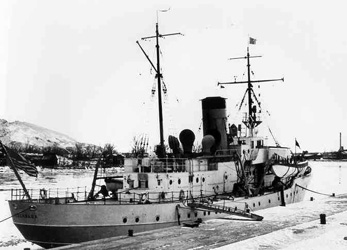 |
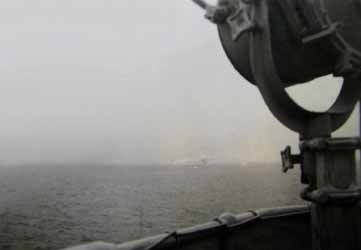 |
12. USCGC Escanaba (WPG-77). |
13. An iceberg is spotted about a mile away from Storis in 1943. |
 |
 |
| 14. While on Greenland Patrol escort duty two convoy ships are seen off the starboard side of Storis. | 15. This photo gives a feeling for the size of the waves which were common during the terrible winter storms that plagued Allied convoys throughout the war. |
With a length of 230 feet Storis carried two 3"/50cal guns, four 20mm Oerlikon cannons, depth charges, and mousetrap mortars.
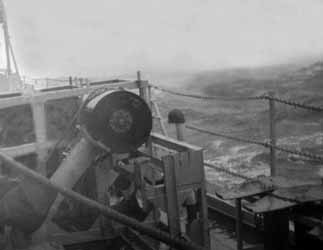 |
 |
| 16. Here we can see a K-gun depth charge launcher against the backdrop of heaving ocean swells, freezing rain, and biting winds. | 17. John shot this photo of a depth charge rack and a covered gun position as the deck of the ship pitches from the rough seas. |
In August 1943 Storis escorted a convoy to Frobisher Bay in
the Canadian Arctic and she helped search for survivors of the US Army
Transport Nevada which foundered and sank on December 18th 1943. During most
of January 1944, the cutter broke ice in the Greenland fjords and transported
supplies to various stations.
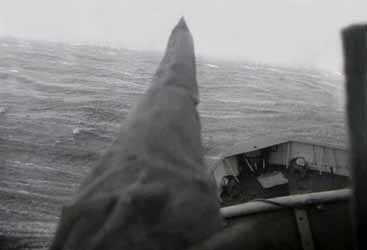 |
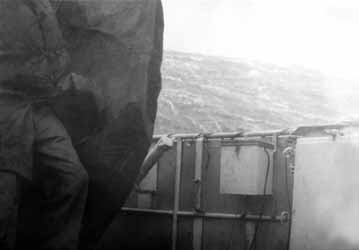 |
| 18. The freezing wind howls across the bow of an escort ship on North Atlantic convoy duty in 1943 | 19. We get a feeling for the size of the waves in this photo John took of a crewman huddled against a gun tarp during a storm. |
On October 5th 1943, Patrol Squadron Six (VP-6) was established at
Narsarssuak, Greenland. Code name Bluie West One (BW-1) it was an
all-Coast Guard aviation unit that served in the hostile environment of
the North Atlantic. The squadron of PBYs served on anti-submarine
patrol, provided air support for convoys, conducted search and rescue,
condition survey, and reporting operations, and delivered mail and
medical supplies. Due to the high number of convoy sinkings, due to
U-boat attacks, and the fierce weather conditions in the North Atlantic,
rescue duties became a top priority for the squadron. VP-6 earned a
reputation as one of the busiest and most effective squadrons in Coast
Guard aviation history. Note: The initialism of "PBY" was determined in
accordance with the U.S. Navy aircraft designation system of 1922; PB
representing "Patrol Bomber" and Y being the code used for the aircraft's
manufacturer, Consolidated Aircraft.
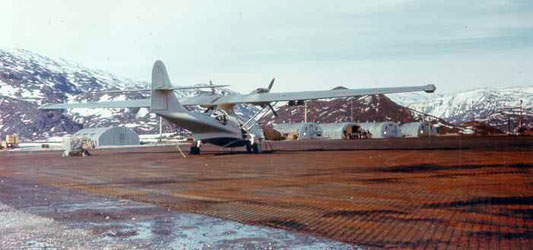 |
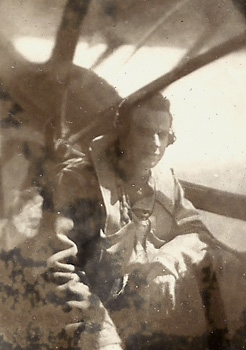 |
| 20. This rare color photo from the 1940s shows a Coast Guard PBY at the Bluie West airfield on Greenland. We can see the Quonset huts of this isolated Arctic base in the background and the steel matting that served as the flight line and runways. (USCG Photo) | 21. John on Radio Duty inside the distinctive bubble window or "blister" of a Coast Guard PBY. |
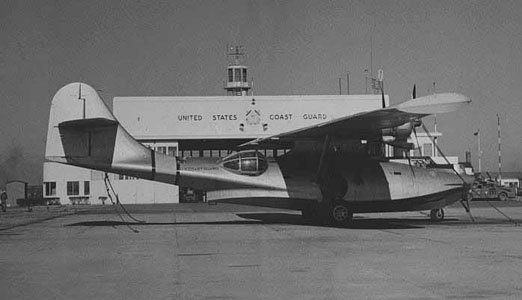 |
22. With a range of over 2500 miles, the Consolidated PBY-5A Catalina was a long range amphibious aircraft ideally suited to the rescue and support operations the Coast Guard performed out of Greenland throughout World War II. (USCG Photo) |
After his time on the Storis he was re-assigned to the Pequot when they needed a top notch radioman. Even though John was involved as the Pequot's radio operator and heard all ship to shore radio traffic he had no idea that the cables the Pequot put down and repaired were part of a top secret submarine detection system.
